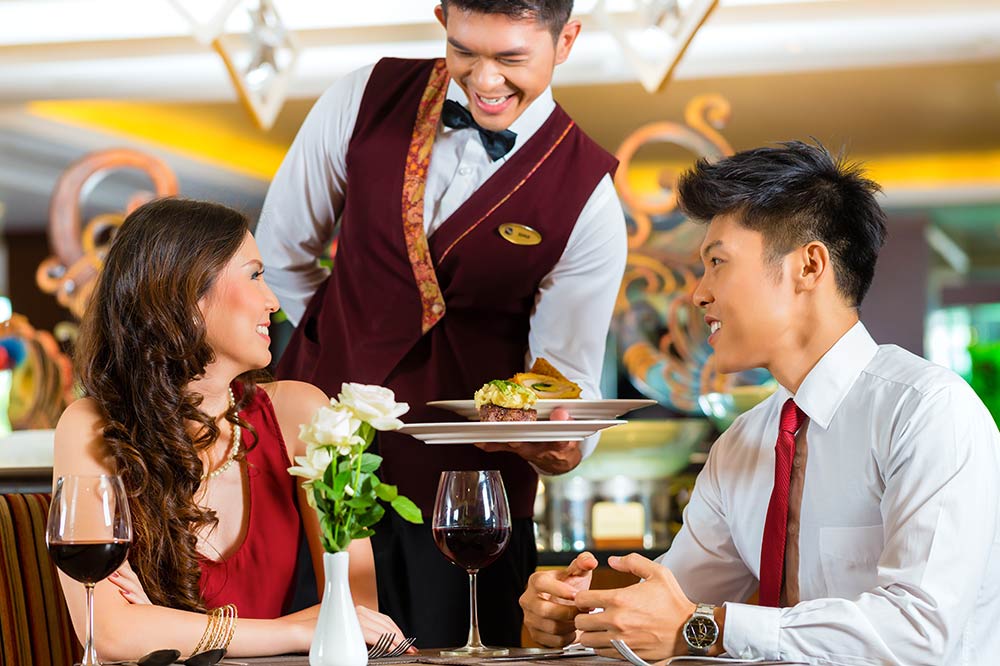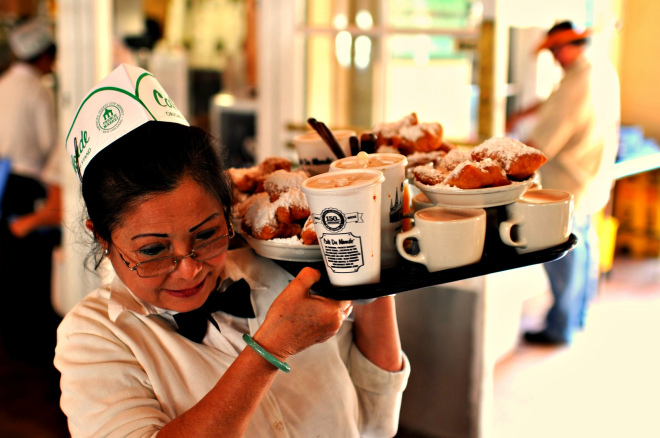So You Would Like to Be a Fine Dining Restaurant Server (Article)
Contents:
Until employees learn where to place plates, napkins, and cutlery, rulers can be used to measure the distance between the edge of the table and the dinnerware, to make sure all tables in a restaurant stay consistent. Serving the Table - Most upscale dinners will include 5 courses, encompassing an appetizer, soup, salad, entree, and dessert. Plates should be rotated when being served so the protein of a dish is facing the guest, as opposed to a vegetable.
If customers need to get up from the table to use the restroom, or make a phone call, napkins are placed on the chair to indicate the meal is not yet finished. Removal of plates should always be conducted from the right of the guest, as this is industry standard. For meals with multiple courses, empty glasses and plates should be cleared prior the arrival of the next course.
Whatever you want to do, do it now. Life is too short!
Regardless of a restaurant's size or style, the serving staff represents the face of every dining establishment. These individuals will interact the most with your customers during a visit, and positive interactions can go a long way towards ensuring those same patrons return.
Hiring the right employees for the job from the start is always ideal, but the introduction of a structured server training program can pay huge dividends for your business. The following guidelines for restaurant server training will help establish an effective, knowledgeable staff and should remain as focal teaching points for all employees.
Etiquette These days, restaurant servers are required to perform more than just "service with a smile.
- Bad Leadership: What It Is, How It Happens, Why It Matters (Leadership for the Common Good).
- 2. Appearance;
- .
- Venus on Fire Mars on Ice: Hormonal Balance - The Key to Life, Love and Energy.
- Six Centuries of Work and Wages.
There's something special about eating at a fine restaurant. The elegant waiting staff with impeccable manners, fancy cutlery, aroma of expensive wine, and delicious meals give customers a sense of importance. Of course, experiencing the wonderful feelings and savory cuisine that accompany fine dining requires shedding some cash, perhaps more than most people are willing. At many high-end restaurants, customers can expect to spend hundreds of dollars for a meal. There are plenty of customers who are willing to pay top dollar for the optimal experience. However, many others prefer eating in a casual restaurant setting; the food is often well-made yet far less costly.
If you're thinking about starting a restaurant, selecting the right path is. A charger plate is a large, decorative base setting for which other dinnerware is placed on top of during formal occasions such as catered events, weddings, upscale parties, banquets, or in fine dining restaurants.
Also known as service plates, under plates, or chop plates, charger plates are merely decorative, and are not meant to come in direct contact with food. Charger plates provide an elegant way to serve multiple course meals, where each course is served in its own separate bowl or plate, and placed on top of the charger.
Subscribe now for great deals and industry tips! Sign up for our mailing list to have weekly discounts and industry knowledge sent right to your inbox.
Server’s Bible: 101 Tips How To Be A Good Restaurant Waiter
At WebstaurantStore we love sharing our fun! Check out some of our weekly Instagram posts! We might even have a recipe or two to share! Based in Lancaster, PA, WebstaurantStore is the largest online restaurant supply store serving food service professionals and individual customers worldwide. With thousands of available products and over 5. Do not interrupt a conversation.
Especially not to recite specials. Wait for the right moment. Do not recite the specials too fast or robotically or dramatically. It is not a soliloquy.
Obviously, something went wrong. Tips about how to be a good waiter, starting from greeting to customers to seeing them out, were very nicely presented by Bruce Bushel. For the purpose of waiter training, be sure to give new employees the chance to practice their technique through the use of role-playing exercises. Back of House In order for a successful restaurant to flourish, there are many parts that must work together to create a positive experience and end result for the consumer. From customer service and sommeliers, to place settings and posture, there are many rules and standards that are expected to be followed when working in a formal dining environment. Libbey Vina
This is not an audition. Do not hustle the lobsters. If someone requests more sauce or gravy or cheese, bring a side dish of same. Let them help themselves. Do not take an empty plate from one guest while others are still eating the same course.
If someone is unsure about a wine choice, help him. That might mean sending someone else to the table or offering a taste or two. If someone likes a wine, steam the label off the bottle and give it to the guest with the bill. It has the year, the vintner, the importer, etc. Never let the wine bottle touch the glass into which you are pouring. No one wants to drink the dust or dirt from the bottle.
Never remove a plate full of food without asking what went wrong. Obviously, something went wrong. Never touch a customer.
Do not do it. Do not brush them, move them, wipe them or dust them. Do not drink alcohol on the job, even if invited by the guests. It has a tone of insincerity or sarcasm. Do not ask what someone is eating or drinking when they ask for more; remember or consult the order. If there is a service charge, alert your guests when you present the bill. Know your menu inside and out. Regardless of a restaurant's size or style, the serving staff represents the face of every dining establishment.
These individuals will interact the most with your customers during a visit, and positive interactions can go a long way towards ensuring those same patrons return. Hiring the right employees for the job from the start is always ideal, but the introduction of a structured server training program can pay huge dividends for your business. The following guidelines for restaurant server training will help establish an effective, knowledgeable staff and should remain as focal teaching points for all employees.
Server’s Bible: Tips How To Be A Good Restaurant Waiter - POS Sector
These days, restaurant servers are required to perform more than just "service with a smile. These particular tips are touched on in our Fine Dining Etiquette for Servers article, but by no means does the list stop there. An ideal server will be social and engaging as well as polite and approachable.
While it may be difficult to "teach" the best social skills, your servers should nonetheless be encouraged to make customers feel welcome. Guests are looking for a wait staff with a positive attitude, cheery disposition, and willingness to accommodate any request from the start of the meal to the very end. An exceptional server is great at reading a customer's personality. Sometimes, this means being able to recite the entirety of the menu, specials, wine list, etc.

It's the server's job to discern this and act accordingly. For the purpose of waiter training, be sure to give new employees the chance to practice their technique through the use of role-playing exercises. With this method, a variety of common interactions can be touched on, all within the span of just a few minutes.
In addition, this method can prepare new staff members with the proper responses to complaints or upset customers. A sloppy uniform can serve as a red flag for any number of new guests. The presence of stains, wrinkles, or creases suggests a disregard for professional appearance.
Types of Table Service
Encourage your staff members to be mindful of their server outfits at all times. It also helps to have extra, clean uniforms available in the event of an improper uniform that needs to be changed. Try to clearly define all appearance standards and expectations when new employees begin working. This includes their uniforms, hair, jewelry, facial piercings, and finger nails as well. These details are small, but will be a large focus for any waitress training program. Make it a priority to discuss these things at length during server training, and make the dress code requirements readily available within an employee handbook.
Just as important as appearance and etiquette is a working knowledge of the restaurant and its food offerings. Even the most descriptive of menus still require clarification from time to time, and your wait staff should be as familiar as possible with the menu. The best serving staff should be able to not only explain in detail each menu item, but also provide suggestions, recite any daily specials with ease, and answer a customer's questions.
Prepping your new staff with this vital knowledge may seem like a daunting task, but it can actually lend itself to some fun and easy memorization games during restaurant server training.
- Restaurant Server Training | Waiter Training Guidelines!
- Fine Dining Etiquette for Servers | Fine Dining Server Etiquette.
- Hay Fever Relief.
- The Third Side (Battle for the Solar System, #2) (The Battle for the Solar System Series);
- !
- Protector -- Book 3 of the HaChii Concatenation;
For example, the more experienced employees can quiz others on key items and their respective ingredients. Challenge your new employees to take time memorizing and reading on their own as well, and in the event of a customer question they cannot answer, ensure that they know who to ask at any given time in order to get an answer. Customer satisfaction can depend largely on two things—taste and efficiency. The latter is difficult to accomplish if your servers remain unaware of the fastest routes to and from the kitchen, in addition to other important stops such as storage rooms, restrooms, and the emergency exits.
During waiter or waitress training, be sure to identify key routes to the most important parts of the facility.

Additionally, your staff will always want to be aware of the surroundings, so point out potential problem areas as well.